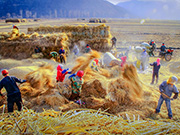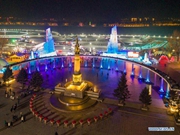

The British Museum
Symbol of the Moon: Gayer-Anderson Cat
Unlike the ancient Chinese who worshiped the Jade Rabbit as a symbol of the moon, the ancient Egyptians believe that Bastet, the cat goddess, is the “Eye of the Moon.” With a cat face and a human body, Bastet is often recognized as a goddess of pregnancy and childbirth, possibly due to the fertility of domestic cats. She is also taken as the protector of family, who shields her believers from contagious diseases and evil spirits.
Based on Bastet’s mythologies, ancient Egyptians have created countless artwork regarding cats, with the Gayer-Anderson Cat being one of the most famous. A bronze figure depicts Bastet wearing a silver protective pectoral and a nose ring, as well as golden earrings. The scarab beetle on the cat’s head and chest symbolizes rebirth, while the silver wedjat-eye on the pectoral invokes protection and healing.
The statue most likely comes from an ancient Egyptian temple, and is named after Major Robert Grenville Gayer-Anderson, who donated the statue to the British Museum in 1939.
The British Museum’s mooncake gift box also contains a moon chart that shows the lunar phase change from a crescent moon to a full moon.
Innovative mooncake flavor:
Traditionally mooncakes are made using pastry, but the British Museum has tried a different way, creating its own chocolate mooncake. The moon on each cake is made by white chocolate, while the cake itself is pure black chocolate. The chocolate mooncake has two flavors, coconut and rum, defying mooncake tradition.
 |  |

 Award-winning photos show poverty reduction achievements in NE China's Jilin province
Award-winning photos show poverty reduction achievements in NE China's Jilin province People dance to greet advent of New Year in Ameiqituo Town, Guizhou
People dance to greet advent of New Year in Ameiqituo Town, Guizhou Fire brigade in Shanghai holds group wedding
Fire brigade in Shanghai holds group wedding Tourists enjoy ice sculptures in Datan Town, north China
Tourists enjoy ice sculptures in Datan Town, north China Sunset scenery of Dayan Pagoda in Xi'an
Sunset scenery of Dayan Pagoda in Xi'an Tourists have fun at scenic spot in Nanlong Town, NW China
Tourists have fun at scenic spot in Nanlong Town, NW China Harbin attracts tourists by making best use of ice in winter
Harbin attracts tourists by making best use of ice in winter In pics: FIS Alpine Ski Women's World Cup Slalom
In pics: FIS Alpine Ski Women's World Cup Slalom Black-necked cranes rest at reservoir in Lhunzhub County, Lhasa
Black-necked cranes rest at reservoir in Lhunzhub County, Lhasa China's FAST telescope will be available to foreign scientists in April
China's FAST telescope will be available to foreign scientists in April